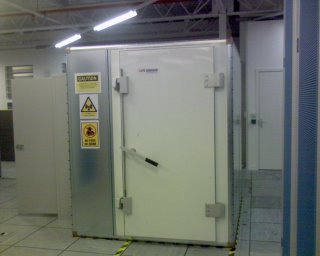Faraday cage
The first Faraday cage was build by Michael Faraday in 1836 (amazing). I have been working in one of these cages during last week and I thought I could be interesting to write a few things about it and the "test cases" I was carrying out in it. I knew the basic concept for it before entering the cage, but I have been doing some research and I decided to share it with you :)
A Faraday cage will look pretty much like this (sorry for the quality of the pictures, I just took them with my telephone):


The concept of a Faraday cage comes from the electromagnetic field theory. The cage itself is a metallic enclosure that can be considered as a conducting surface. The ideal case would consist of a perfectly conducting shell, with no holes or irregularities... but (as it usually happens) this ideal cage cannot be achieved in practice. So... how is it solved? It is proved that any hole smaller than (approximately) a wavelength cannot be penetrated by electromagnetic waves, therefore, reflection of such electromagnetic waves is not affected by those holes and the desired performance of the cage can be achieved.
And what's the desired performance of the cage? We want to isolate the cage from any electromagnetic field surrounding it and this is simply achieved by applying the statement above and by using electromagnetic field theory. (*Stop reading now if you know nothing about physics, really!*) Electric fields produce forces on the electrons (particles that carry charge) within a conductor. Once the electric field is applied to the surface of the cage, it generates a current that causes displacement of charge inside the conductor and, therefore cancels the applied field inside.
This is important in the testing of wireless receiving equipment; Faraday cages are used in electronic labs where electromagnetic fields must be kept out, even though it can be used for other applications, as for preventing the "escape" of such fields from the cage.
And why was I using a Faraday cage? I was trying to perform some IRAUs (Inter-SGSN Routing Area Update) from a 2G mobile network to a 3G. I guess you might be wondering what the actual meaning of this is... Well, imagine you live in a city like London and suppose we have two SGSNs to cover all the surface London occupies (talking about kilometers here, nothing complicated ;)) . You turn on your telephone and you attach to a first SGSN, the closest to your current position.
I assume you are not going to stay where you are for ages, so let's suppose you start walking around, then you take a bus, metro... whatever. Suddenly, and without you noticing it (you do not notice it even while you are talking, wireless communications are incredible) you are attached to a second SGSN because you are outside the area covered by the first one :) That is basically and IRAU :)
I needed the Faraday cage because the signal strength for 3G was very low and everytime I tried and IRAU I was attached to a SGSN I did not want, which belonged to an external network. Just to make this clear, let's say I wanted a SGSN from one operator (like O2, for example :)) and I was attached to a SGSN from a different one, which I cannot access and I definitely do not work with.
That's it :) I have not forgotten about the SGSN, I know I still have one post due about it...
P.D: Carolina, I know this is much more your speciality than mine, so if I made any mistake... let me know :) And remember... we are engineers, we mess up with all the work you physicists do!! :))))
Updated information: I forgot to mention that the same effect observed in a Faraday cage can be compared to a microwave; a microwave contains panels that will keep the electromagnetic fields inside the box, not letting them out.
And last, but not least... have you ever thought why you lose your telephone's signal when you enter an elevator? Now that you know about Faraday's cage, it should be easy to explain :)

3 Comments:
Super bien esplicado con los campos y eso... para mi es mas facil de entender con el fenomeno de la esfera conductora, pero con tu explicacion me queda mas claro :)... Oye que bien que estes dentro de esas clautrofobicas cajas jajaja... a mi me daba sueño y apagaba la luz y dormia :).
Que entretenido lo que estas haciendo, creo que cuando nos veamos tendremos una larga conversacion sobre tu trabajo.
Beso beso y me gusta tu lado Cientifico-Ingenieril no son muchos los que se dedican a ver mas ;). Carolina
Muy bien explicado, no se te daría mal la docencia ;)
alberto
Alberto... ya me lo han propuesto alguna vez y es una idea que no descarto del todo, pero por ahora disfruto de lo que hago, así que no lo considero una opción a corto plazo :)
Besos,
Ylenia
Post a Comment
Subscribe to Post Comments [Atom]
<< Home